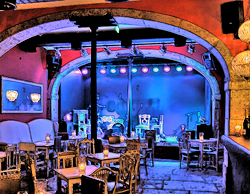
Making the Patrons Pay Twice
HF threshold shift can affect the audience as well as the musicians and the sound person.
The instrument amplifier loudspeakers are often mounted at the musician’s hip-height. This beams the highs straight out. So while the musicians don’t get exposed to the highs, the sound is aimed right at the audience.
However, the musician’s do get the highs from the drums because the sound, unless confined somehow, is washing all around the stage area – cymbals, for example, will reflect off the floor, walls, and ceiling. These reflections must be controlled in order to optimize your stage acoustics.
A method for selective absorption of low frequencies and an extension of the principle to broadband absorption in a slat absorbers which are practical renditions of the Helmholtz resonator. The absorber consists of resonant chambers (space between slats) connected to an air mass spring (the volume behind the slats). The absorption spectrum may be broadened by the addition of damping material between the two as shown.
Acoustic, rather than electronic “equalization, is necessary because the reinforcement system has no effect on the local acoustic response of the environment to the musicians and their instruments. What can be done in most cases is to use combinations of reflection, diffusion, and absorption, arranged to focus and control the drum sound.
A reflector panel is very helpful behind the drums. Such panels can be fashioned from thick 3 ft (1m) x 6 ft (2 m) plexiglass sections, joined with piano hinges, and fitted with edge trim. Placing the drums on a riser also helps. Still, practically speaking, you can’t stuff the drummer in the rafters, and even if you could, most drummers won’t stand for it.
Large instrument and equipment cases, instead of being the usual pain in the neck to store until moving on to the next gig, can be used strategically to break up any plane surfaces in the rear of the stage. This increases the low and middle frequency absorption coefficient.
Artfully covering a stack of them with drapes or curtains will help break up the highs as well. Just as is done in the recording studio it is sometimes advantageous to place a large beach umbrella, or some similar semi-absorbent surface, above the percussion instruments. Normally much of the sound goes straight up into the ceiling and then returns within milliseconds, its spectrum altered by the complex attenuations of the transit and reflection.
Reflections of drum and percussion sounds contribute to poor sound quality as well as threshold shifts, not only among the musicians on stage, but also in the audience, since the mics pick up the reflections. The umbrella or other semi-absorptive material above the percussion cures both problems.
Otherwise, when near a microphone element, the reflected ceiling sound will meet sound reflected from the floor. If the sound is approximately equal from both reflections, an addition or cancellation may occur at various frequencies, depending upon the relative phase relationships. The result will be unpredictable.
